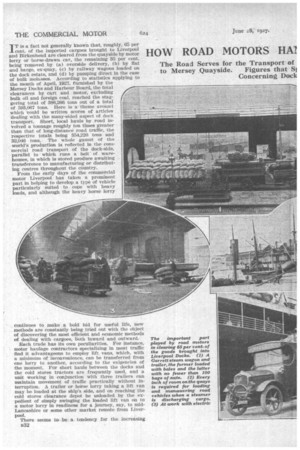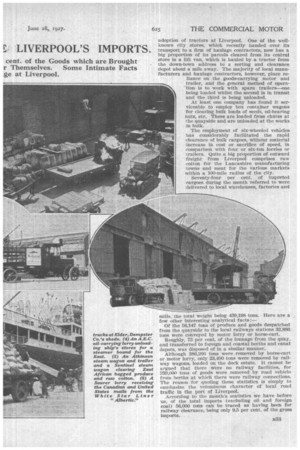HOW ROAD MOTORS HAT LIVERPOOL'S IMPORTS.
Page 50

Page 51

Page 52

If you've noticed an error in this article please click here to report it so we can fix it.
The Road Serves for the Transport of to Mersey Quayside. Figures that Si Concerning Dock cent. of the Goods which are Brought r Themselves. Some Intimate Facts ge at Liverpool.
IT is a fact not generally known that, roughly, 65 per cent, of the imported cargoes brought to Liverpool and Birkenhead are cleared from the quayside by motor lorry or horse-drawn ear, the remaining 35 per cent. being removed by (a) overside delivery, (b) by flat and barge, ex-quay, (c) by railway wagons loaded on the dock estate, and (d) by pumping direct in the case of bulk molasses. According to statistics applying to the month of April, 1927, furnished by the Mersey Docks and Harbour Board, the total clearances by cart and motor, excluding bulk oil and foreign coal, reached the staggering total of 386,266 tons out of a total of 593,067 tons. Here is a theme around which could be written scores of articles dealing with the many-sided aspect of dock transport. Short, local hauls by road involved a tonnage roughly ten times greater than that of long-distance road traffic, the respective totals being 354,220 tons and 32,046 tons. The whole gamut of the world's production is reflected in the commercial road transport of the dock-side, parallel to which runs a belt of warehouses, in which is stored produce awaiting transference to manufacturing or distributing centres throughout the country.
, From the early days of the commercial motor Liverpool has taken a prominent part in helping to develop a type of vehicle particularly suited to cope with heavy loads, and although the heavy horse lorry continues to make a bold bid for useful life, new methods are constantly being tried out with the object of discovering the most efficient and economic methods of dealing with cargoes, Uoth inward and outward.
Each trade has its own peculiarities. For instance, motor haulage contractors specializing in meat traffic find it advantageous to employ lift vans, which, with a minimum of inconvenience, can he transferred from one lorry to another, according to the exigencies of the moment. For short hauls between the docks and the cold stores tractors are frequently used, and a unit working in conjunction with three trailers can maintain movement of traffic practically without interruption. A trailer or hdrse lorry taking a lift van may be loaded at the ship's side, and on reaching the cold stores clearance depot be unloaded by the expedient of simply swinging the lbaded lift van on to a motor lorry in readiness for a journey, say, to midLancashire or some other market remote from Liverpool.
There seems to be a tendency for the increasing B32 adoption of tractors at Liverpool. One of the wellknown city stores, which recently handed over its transport to a firm of haulage contractors, now has a big proportion of its parcels cleared from its central store in a lift van, which is hauled by a tractor, from the down-town address to a sorting and clearance depot about a: mile away. The majority of local manufacturers and haulage contractors, however, place re liance on the goods-carrying motor and trailer, and the general method of opera tion is to work with spare trailers—one being loaded whilst the second is in transit and the third is being unloaded.
At least one company has found it serviceable to employ box container wagons for clearing bulk loads of seeds, oil-bearing nuts, etc. These are loaded from chutes at the quayside and are unloaded at the works in bulk.
The employment of six-wheeled vehicles has considerably facilitated the rapid clearance of bulk cargoes, without material increase in cost or sacrifice of speed, in comparison with four or six-ton lorries or trailers. Quite a big proportion of outward freight from Liverpool comprises raw cotton for the Lancashire manufacturing towns and meat for the various markets within a 100-mile radius of the city.
Seventy-four per cent. of imported cargoes during the month referred to were delivered to local warehouses, factories and
mills, the total weight being 439,198 tons. Here are a few other interesting analytical facts:—
Of the 56,147 tons of produce and goods despatched from the quayside to the local railways stations 32,886 tons were conveyed by motor lorry or horse-cart.
Roughly, 75 per cent. of the tonnage from the quay, and transferred to foreign and coastal berths and canal depots, was disposed of in a similar manner. Although 386,266 tons were removed by horse-cart or motor lorry, only 23,400 tons were removed by railway wagons, loaded on the dock estate. It cannot be argued that there were no railway facilities, for 239,000 tons of goods were removed by road vehicle from berths at which there were railway connections. The reason for quoting these statistics is simply to emphasize the voluminous character of local road traffic in the port of Liverpool. According to the month's statistics we have before us, of the total imports (excluding oil and foreign coal) 56,000 tons can be traced as having been for railway clearance, being only 9.5 per cent, of the gross imports. Of the direct clearances from the dockside, 32,000 tons were taken by road motor to outside the districts and 23,200 tons by railway.
Every year motor vehicles. carrying nearly 5,000,000 n e t tons of merchandize, or more than onethird of the tonnage passing through the port annually, cross the boundaries of the city. These figures are quoted on the authority of the ex-city, engineer, who applied an analytical mind to the traffic problems of the city and port. Within the period of the past 15 years the tonnage using some of the busiest city roads has increased from 12 to 20 times, and is still growing. Since the road communications to and from the docks are• congested, traffic speeds are necessarily governed by the rate of progress of-the slowest-moving vehicles, namely, the horse-drawn lorries, which, it is disclosing po secret to say, carry loads of a weight comparable to those borne by the heavieat self-propelled vehicles.
The ever-growing range of petrol and steam wagons has naturally-encouraged their employment instead of sending goods by railway, which necessarily increases the number of times they must be handled.
In certain sections of the dock estate electric trucks are employed for the handling of a range of commodities as dissimilar as meat and timber, barrels of palm oil and tebacco. The first tractor used for the haulage of African mahogany logs at Liverpool was put into service about 12 years ago, and had a hauling capacity of about ten tons. In recent years improved types have been. commissioned. The African mahogany logs thus transported vary in weight from one ton to eight tons, the average being about three tons, and in ordinary circumstances would require, when dealing with an eightton log carried on • a fourwheeled stiff bogie, as many as 20 men to haul it. An electric tractor can convey the same log at approximately twice tile speed, and with the employment of only three men, one mandriving the tractor and two men at the tail of the log to steer it.
This form of traction is probably one of the cheapest, since in dock-shed transport there are very suitable conditions of operation, including abundance of traffic, facilities for rapid loading and unloading, and journeys that rarely exceed 300 yards. When mall-carrying steamers arrive at the Liverpool landing Stage electric trucks are always in attendance to run mails and passengers' luggage from the ship's side up the bridges to the pier head to the waiting motor mail vans and to the customs department respectively.
No review of dockside transport would be complete without a reference to the important part played by the light van and lorry. Whilst heavier types of vehicle are employed in clearing tonnage from the ship's side, and similar types are used for the conveyance of outward cargoes. lighter loads, as ships' supplies, foodstuffs, linen and general stores, are as a general rule delivered by lorries and vans of less than • two tons load capacity.
Even big fleet operators find ample scope for -the operation of light units for emergency traffic and runabout work. Cartage contractors all have their "runners," whose function it is to locate traffic and to report to headquarters with a view to the transport contract being obtained and to supervise its execution. Although the use of horse traps is still popular, the motorcar is now being more commonly used.




































































































